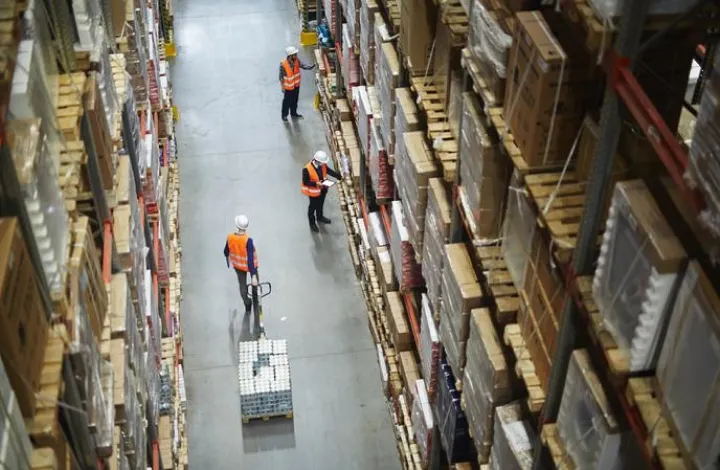eCommerce order fulfillment has become more relevant today since many people purchase online. However, this has proven to be a challenge for businesses and warehouse managers since consumers expect fast delivery times and low shipping costs. One way to achieve this is by optimizing your eCommerce order fulfillment process to ensure customers are satisfied and continue patronizing your business.
This article will discuss what eCommerce order fulfillment is, the steps involved in the process, and how you can optimize them. When this is accomplished, you will achieve a higher perfect order rate, increasing customer satisfaction. Learn more below.

What is eCommerce Order Fulfillment, and Why Does It Matter?
eCommerce order fulfillment is the entire process a warehouse goes through when customers place their order online until the package arrives at their doorstep. This makes it an integral part of your warehouse process since eCommerce sales have been soaring in the past few years compared to traditional brick-and-mortar stores.
Consumers are also expecting faster delivery times, which affects their decision on whether to purchase a particular product or not. As much as 53% of shoppers consider delivery speed as one of the most critical factors when evaluating their online orders, and up to 25% of shoppers cancel their orders because of slow delivery speeds.
Now that we have discussed eCommerce order fulfillment and why it is vital in your operations, let’s look at the steps in the process.
eCommerce Order Fulfillment Processes and How to Optimize Them
The eCommerce order fulfillment process starts even before an order is placed online. There are necessary steps a warehouse must take to ensure that the process is streamlined and customers can get their packages in full and on time. Here are the five steps to ensure the process:
1. Inventory Management
The first step in eCommerce order fulfillment is inventory management. This is a step wherein warehouses must request and receive the goods for sale from manufacturers to stock up on inventory and accommodate all incoming orders. However, the number of goods you must request and receive will be based on the product’s seasonality or demand, which requires you to conduct forecasting to acquire the right amount. If you store too much of a particular item, you risk losing potential sales from in-demand items. Conversely, if you hold too little, you will run out of stock and miss out on possible deals.

How to Optimize:
To optimize the inventory management process, you can implement ABC analysis. This allows you to categorize stocks based on demand and have better control over the in-demand items.
Also, you can implement the JIT (Just-In-Time) inventory system wherein the items are manufactured or produced just before they are needed. This technique aligns production schedules and orders from suppliers, so understocking or overstocking is mitigated as much as possible.
Utilizing these two techniques will increase efficiency, leading to higher customer satisfaction rates.
To learn more about other methods you can use to optimize your inventory management, click here.
2. Order Management
The subsequent step for eCommerce Order Fulfillment is order management, where you track all incoming orders from online sales. In this part, customer orders have already been placed.
Once your warehouse receives an order, it begins the order fulfillment cycle time. It’s crucial to optimize this process to ensure that you process all orders correctly and promptly for delivery to customers.
How to Optimize:
One way to make this process more efficient and accurate is by syncing your order management to your inventory management. This will allow you to keep track of pending orders, orders to be picked, and shipped orders since the information is reflected in the system in real time. Ultimately, it will lead to faster fulfillment times and accurate orders that will help you meet the customer expectation of quick delivery.
3. Picking and Packing
After a customer orders online, you must be ready to execute the succeeding steps—picking and packing—to ensure their packages are delivered as quickly as possible. This process in eCommerce order fulfillment is crucial to perform with high efficiency and accuracy to maintain the perfect order rate of your warehouse.
Furthermore, it is detrimental to a customer’s experience when they receive the wrong package, whether it lacks certain items or the order is incorrect altogether. Such an experience will harm their satisfaction and undoubtedly impact their future purchase decisions, so optimizing this process is critical.

How to Optimize:
Utilizing mobile technology, such as barcode & RFID scanners, will significantly impact its accuracy and efficiency to optimize this process. Unlike manual data entry, which is prone to human error, scanning barcodes or RFID gives you an almost error-free way of entering data into the system. This will also allow you to have an up-to-date inventory count and real-time visibility, which is crucial in scheduling orders as accurately as possible.
To learn more about the ways to optimize your pick and pack process, read this article.
4. Shipping
Now, it’s time for you to ship the goods to the customer after completing all the aforementioned procedures, assuming that you have carried out all prior procedures quickly and accurately. In that case, you can deliver the goods to consumers in full and on time, increasing customer satisfaction and the likelihood of them conducting their business with you again.
How to Optimize:
Completing documentation well ahead of shipping helps achieve faster delivery by avoiding unnecessary delays. Also, to expedite the shipping process, allocate enough manpower and equipment so customers receive their packages on time.
To learn more about the best practices in the shipping process, click here.
5. Returns
Finally, eCommerce order fulfillment may not end in the delivery of orders. You must also consider that customers may want to return the items for other reasons even though you have delivered the correct order on time. As much as 30% of all products ordered online are returned compared to 8.89% in brick-and-mortar stores. With a higher return rate, you must be prepared to facilitate this process efficiently and make it as easy as possible for the consumer.

How to Optimize:
One way to optimize your returns management is to dedicate an area for returns. Once you have done this, you need to sort them by category. Use a three-bin system – restock, discard, and return to supplier – to keep your stock organized and ensure that each item is routed to its appropriate destination.
Successful management of this process can reduce costs and increase customer satisfaction, helping you stay ahead of the competition.
To learn more on how you can optimize your returns management, read this article.
Summary
eCommerce order fulfillment is an integral part of your warehouse processes, given the significant growth of e-commerce. Once you have successfully optimized your eCommerce order fulfillment process, you will deliver on your promises to consumers while reducing the costs for your warehouse. This, in turn, will create a positive impression on your customers and increase their overall satisfaction.
If you want to learn about warehouse technology and optimizing warehouse processes, follow us on LinkedIn, YouTube, X, or Facebook. If you have other inquiries or suggestions, please contact us here. We’ll be happy to hear from you.
















